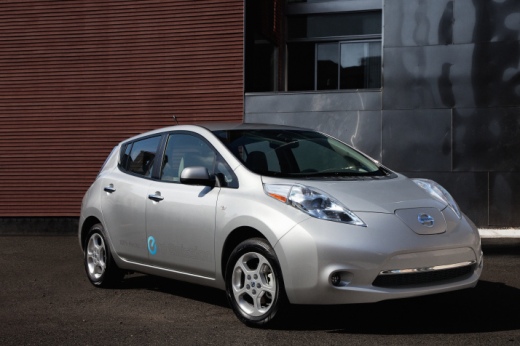 I’m not a proponent of alternative fuels, alternative power, hybrid cars or anything other than the internal combustion engine. We’ve come nowhere near the end of what an internal combustion engine is capable of. Fuel mileage can be dramatically increased if we’d all just get used to the fact that our workaday passenger cars can’t weigh 4,000 pounds and have creature comforts unheard of in the most exclusive luxury cars just a few decades ago. And when the shit does finally hit the fan, most of us already have the technology to deliver infinity miles per gallon by just working from where we are, rather than schlepping into an office every goddamned day.
I’m not a proponent of alternative fuels, alternative power, hybrid cars or anything other than the internal combustion engine. We’ve come nowhere near the end of what an internal combustion engine is capable of. Fuel mileage can be dramatically increased if we’d all just get used to the fact that our workaday passenger cars can’t weigh 4,000 pounds and have creature comforts unheard of in the most exclusive luxury cars just a few decades ago. And when the shit does finally hit the fan, most of us already have the technology to deliver infinity miles per gallon by just working from where we are, rather than schlepping into an office every goddamned day.
That said, in certain, ideal circumstances, the Leaf works. Let’s start off where it’s not going to work: anywhere the temperature doesn’t hover between 55 and 78 degrees. Anywhere with steep hills. Anywhere the commute involves long stretches of highway. Anywhere with expensive electricity. Anywhere you like to leave town. The Leaf is most effective in a city environment where you don’t plan on taking longer trips. That works if you’ve got access to a conventional Zipcar or something that can take you on a trip of longer than 100 miles.
That’s the basic, effective range of the Leaf. You can extend that range in a number of ways, including not driving like an asshole. Slow, steady acceleration and avoiding sudden stops increases the mileage significantly.
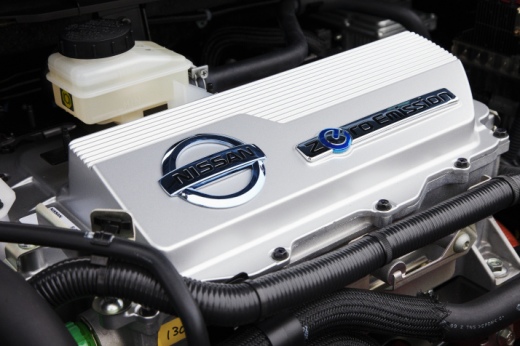
Ceci n'est pas une four-cylinder.
You can also extend the mileage by making yourself ridiculously uncomfortable in the heat and in the cold. The biggest drain on the Leaf’s range is the climate control system. Turning it on immediately reduces your range by about ten percent. So if you live in New England, where the temperature ranges from sub-zero in the depths of winter, to over 100 in the dog days of summer, you’re either going to have to get used to shorter trips, or get used to wearing a union suit and/or a thong depending on the ambient temperature. Better have both at the ready in the spring.
I live in Holliston, Massachusetts and commute regularly to Waltham. As the crow flies, it’s about a 25 mile trip, but with two gagillion other stupid crows on the road at the same time, it translates to about an hour of mixed traffic, including some 40 mph back roads, stop and go town center traffic, and a short, 65 mph stretch of 128.
In the Leaf at a comfortable 70 degrees, I can make that round trip once with plenty of juice to spare for a couple of side trips at lunch, and a run out in the evening. Doing that depletes the Leaf’s battery to the point where a full charge is necessary. Most Leaf owners will also invest in the 240v charger, which cuts charging time from empty to full to about four hours. Plugging it in to a standard wall socket is possible, but not practical. On a standard 120v plug, the Leaf takes about 18 hours to fully charge. I had about a quarter of a charge left when the Leaf arrived at my house. I plugged it in at about 6:00 pm. By 7:00 the next morning, I’d only reached about 85 percent capacity, so the charging station is an absolute must.
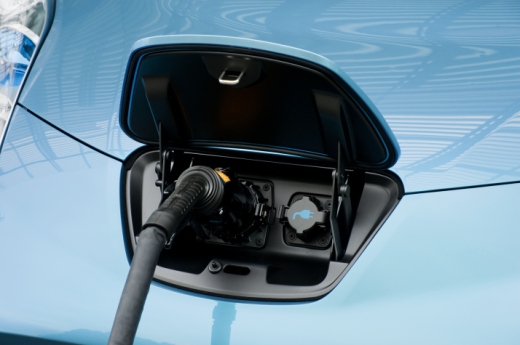
"If you have a better method of exchanging long protein strands, I'd like to hear it."
Getting one requires an electrical assessment that costs $100, which can later be applied to the cost of having a charger installed. The station itself runs about $2,200, provided you don’t have to have your home’s electrical system upgraded. Most modern homes with 200 amp service will be fine, but depending on how far the electrical panel is from the garage could run into additional installation fees. The federal government offers a tax credit of $2,000 for installation, and you can roll the fee for the charging station into the financing of the Leaf.
The first two plugs I tried in my garage were GFCI protected, which most modern homes are going to have. When the charger came on, the draw threw the ground fault interrupter in the outlet. I had to search around for an outlet that wasn’t GFCI protected for the Leaf to charge. I found one at the very limit of the Leaf’s charger’s 15-foot cord. You can’t plug the charger into an extension cord, so the outlet has to be relatively close by.
With an 85 percent charge, I left the driveway with about 85 miles at my disposal. It was a rainy, damp, chilly morning and by the time I hit the end of my street, the windshield had fogged up. I pressed the front window defroster button and my range immediately dropped by 10 miles. Not good. One of the annoying things about the Leaf – and all modern cars, in fact – is that pressing the defrost button not only cranks the fan to high, but also turns on the air conditioning system to evaporate the fog on the window faster. That saps the battery significantly. Simply turning the fan on at a low speed and cracking a window can eliminate a lot of fog, but the Leaf won’t let me do that. Turning the fan down turns off the defroster. Oooo, I hate that. So, to preserve the mileage, I ran with the window slightly open.
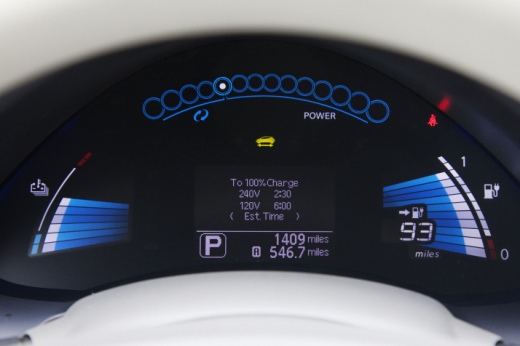
You'll spend too much time staring at this readout. It makes driving like an old lady entertaining
The wipers have a slight effect on range, also, as do the headlights, but there’s a secondary, conventional lead acid battery in place to run those accessories.
One of the biggest faults I have with almost all small, four-cylinder economy cars is that the engines are noisy, buzzy and crude. I really haven’t driven one that wasn’t, even from the most notable four-cylinder producers. That objection is completely off the table with the Leaf. In stop and go traffic, the Leaf is an absolute pleasure. It emits a barely perceptible whine, which, at first, sounds like an ambulance siren off in the distance, but you learn quickly to quit checking your mirrors looking for it. At all speeds, the Leaf is amazingly quiet. Wind noise is at a minimum and what you hear most of is the tires rolling against the pavement. It’s wonderful.
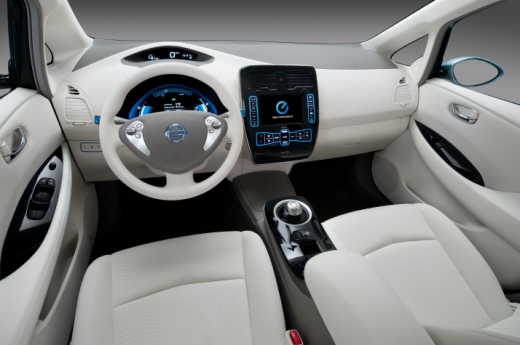
The Leaf's interior is, surprisingly, one of its nicest attributes.
The passenger cabin is fantastic. The seats are comfortable and not too hard, although I would’ve appreciated the nicely padded left armrest that’s on the door of the Versa. The Leaf’s armrest is hard. Inside, the Leaf’s light colored interior and well designed dash makes the car feel twice its size. Visibility is much better than most cars today, and rear seatroom is respectable, even for adults. The cargo area is small, but no smaller than you’d expect from a car in this category. In summary, it works like you want it to. From a comfort and driving perspective, I’ll go out on a limb and say that the Leaf is significantly BETTER than any compact car than I can think of. It’s more comfortable, it’s more pleasant in traffic, and it’s tens of decibels quieter.
But does it work as a car? Not really. The Leaf is priced at $32,780, which is really steep considering you can buy the cheapest Versa for less than $10,000. But the government also credits you a whopping $7,500, which brings the price down to a more reasonable $25,280. But don’t confuse “tax credit” with “tax refund.” You won’t be getting a check from Uncle Sam to help pay the note on the full $32,780 every month.
The cost of electricity in my area is about $.08 a kilowatt hour, which sort of equates to a gas price of about $.75 a gallon, if I can trust the numbers from an article in Scientific American in 2009. I can guarantee they’re better at math than I am. So, over the course of a year, driving an electric car 10,000 miles will save you about $650 per year in fuel cost over a vehicle like the Prius. If I had the charging station, I could get a full charge in four hours. It would be nice if I had a charging station near the office, too, but the closest one is three or four miles away. I assume that will change in the coming years, but today, it’s not an option.
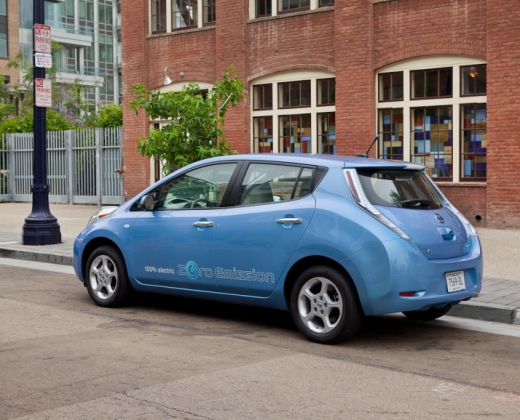
The view a lot of other cars will see...oh, wait a minute.
With a full charge every night, I could get to about 90 percent of the places I need to go…in the three weeks of spring and fall when the temperature is ideal. Air conditioning in the summer would make cut my range significantly, though I’d be more likely to be able to live without A/C than heat. If I had to run the heater on a regular basis, I’d barely have enough range to get to work and back, and I simply can’t drive a car that doesn’t provide heat.
I could run it at a much lower temperature, but when I can get pretty damned good mileage out of a Mini Cooper, fill the tank in any town in America, blast the heat until I had to strip down to my underpants and not worry about whether I can get home, it’s a significantly better option in all practical terms.
I can’t say I don’t appreciate the effort, though. If I lived in San Diego, I think I’d consider one.




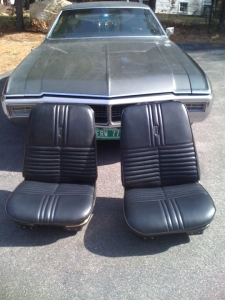
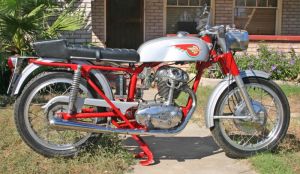






 Two stories in the last few days have cemented my opinion that every news channel should have a legitimate automotive expert on speed-dial, if not on staff.
Two stories in the last few days have cemented my opinion that every news channel should have a legitimate automotive expert on speed-dial, if not on staff.






